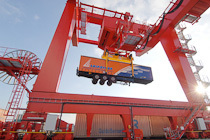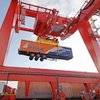ChemLog supports central transport hubs for chemicals goods in Central Germany

In the south of Saxony-Anhalt, representatives of the chemicals industry and logistics service providers are discussing the construction of a central transport hub which should facilitate the transport of chemicals goods to Eastern Europe. Such central transport hubs and transhipment points, in specialist fields simply referred to as hubs, do not have to be constructed from new. The existing and planned terminals can carry out transport hub functions together, explains Andreas Fiedler, Project Coordinator of the European project ChemLog, which is now presenting the results of its work after three years of research.Fiedler is certain that if the existing and planned terminals for the combined road and rail transport in the chemicals locations of Leuna and Schkopau, and in the port of Halle, as well as - maybe - that of the Deutsche Bahn in Leipzig-Wahren were to interlock and cooperate, they could fulfil the function of a transport hub for transport to Eastern Europe. The 34 year old project manager of the Halle firm Isw-GmbH currently coordinates the international ChemLog project, working on behalf of the Ministry of Economic Affairs and the Investment Bank of the Federal State of Saxony-Anhalt. The project was established in 2008 by the senior Chemicals group of the EU on the suggestion of the European Chemicals Regions Network (ECRN) to respond to the expanding logistics requirements in this sector. In those days the President of the ECRN was the current State Premier of Saxony-Anhalt, Dr. Reiner Haseloff.In the year 2000 approximately ten million tons of chemical products were handled in and transported through Saxony-Anhalt. Over the years to come, firms are set to increase the total transport volume to between 50 and 55 million tons each year. A large proportion of this will go eastwards, where the chemicals industry is focusing on key target markets. This is leading to a range of structural disadvantages, however. The chemicals industry in western Europe is strongly integrated and well networked says Fiedler, describing the situation. There are many pipelines and the river Rhine is also a key transport route, offering direct links to key ports in the North Sea. In Eastern Europe, however, over 90% of all transports of chemicals and increasing quantities of hazardous goods are transported by road, which is not only damaging to the environment, but in transport terms, cannot be realised on a sustainable basis over the long term. The pipelines are lacking, the rail capacity is insufficient, and the existing terminals are insufficiently equipped for the requirements concerning the transport of chemicals. The goal of ChemLog has therefore been to highlight ways in which rail links, waterways and pipelines can be developed to benefit the chemicals industry. As much transport as possible should go onto the railways. To create the conditions for such a development, three years ago a consortium was established, bringing together representatives from industrial associations, regions, research organizations and public authorities from Germany, Italy, Poland, Czech Republic, Hungary, Austria and Slovakia, who have been working together under the umbrella of ChemLog.Fiedler views there to be realistic chances for the development a chemicals hub in central Germany. The companies Dow, BASF, Infra-Leuna, the port of Halle and the logistics firm Hoyer are currently in intense discussions. The German Association for the Chemicals Industry e.V. (North East Association) is also supporting the project. Such a hub would also help to further establish Saxony-Anhalt's reputation as a leading logistics centre, highlights Fiedler.Another important result for ChemLog is for the planned Knappenrode - Horka (PL) rail link to go ahead despite the threat of financial shortfalls. This forms part of the Pan-European Transport Corridor III project, stretching from Germany to Moscow via Poland and the Ukraine.The Italian Chemlog partners are also pressing for the development of tank cleaning systems along the route from Northern Italy to Moscow, which will provide special services for the chemicals industry. In Slovakia and Hungary, where there are currently few combined terminals, such systems are set to be constructed in Zahony (H) and Dobra (SK). ChemLog is also pressing for the harmonization of standards, customs regulations and procedures at border crossings. Fiedler views the fact that the European Commission has so far only focused on transport within Europe to be a major policy shortcoming. Rail links beyond the limits of the EU to China, for example, are an increasingly attractive option. The project that has been co-financed by the EU (€ 1.7 million) and the project partners (€ 500,000) is shortly set to end, but the network of chemicals associations, logistics service providers and public partners which never existed before will remain. They are intent on continuing to work together, ensures Fiedler. Along with other partners they are now working on a follow up project which will focus on tracking the transport of hazardous goods in inter-modal transport.Contact: isw Gesellschaft für wissenschaftliche Beratung und Dienstleistung mbHisw Association for scientific consulting and servicesHoher Weg 306120 Halle (Saale)Andreas Fiedlerph: +49(0)345 / 2998-2724E-Mail: fiedler@isw-gmbh.deMinisterium für Wissenschaft und Wirtschaft Sachsen-AnhaltSaxony Anhalt Ministry of Science and Economic AffairsHasselbachstr. 439104 MagdeburgCatrin Gutowskyph: +49 (0)391 / 567-4452E-Mail: catrin.gutowsky@mw.sachsen-anhalt.de Web: www.chemlog.info

